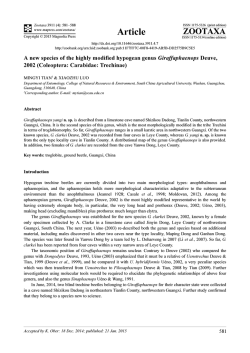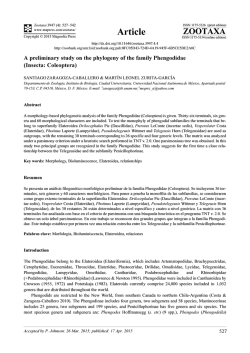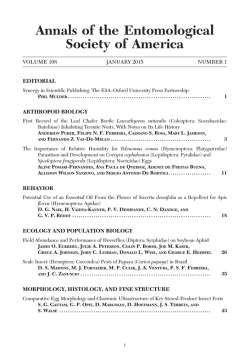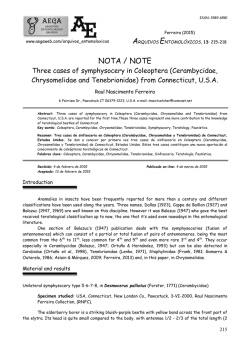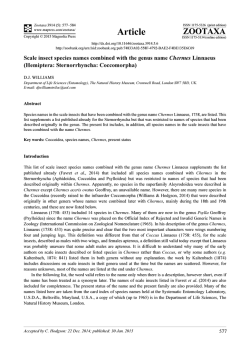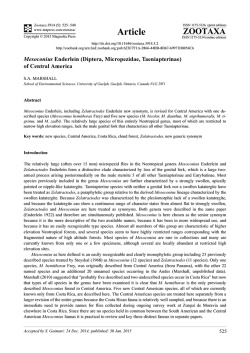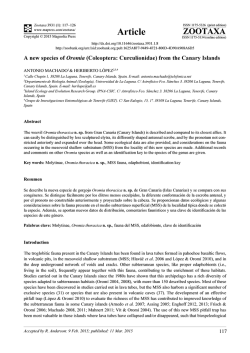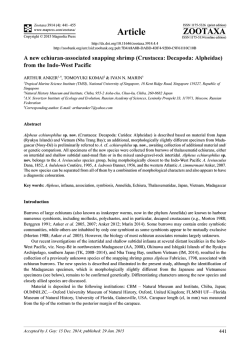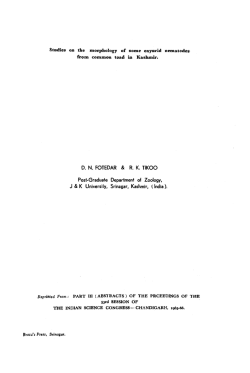
Preview - Magnolia Press
Zootaxa 3915 (1): 143–146 www.mapress.com /zootaxa / Copyright © 2015 Magnolia Press ISSN 1175-5326 (print edition) Correspondence ZOOTAXA ISSN 1175-5334 (online edition) http://dx.doi.org/10.11646/zootaxa.3915.1.9 http://zoobank.org/urn:lsid:zoobank.org:pub:A9759604-CF6B-4F13-931F-2F4F06BDFB56 A new species and synonymy in Elacatophora (Coleoptera, Staphylinidae, Scydmaeninae) PAWEŁ JAŁOSZYŃSKI Museum of Natural History, University of Wrocław, Sienkiewicza 21, 50-335 Wrocław, Poland. E-mail: [email protected] Abstract A new species of the Oriental genus Elacatophora, E. euconnoides sp. n., is described from the Cameron Highlands, West Malaysia. Diagnostic characters, including the male genitalia, are illustrated and discussed. A new case of subjective synonymy was discovered: Elacatophora minae (Makhan & Ezzatpanah, 2011) is placed as syn. n. of E. soesilae (Makhan & Ezzatpanah, 2011). Key words: Coleoptera, Staphylinidae, Scydmaeninae, Cyrtoscydmini, Elacatophora, new species, Oriental, West Malaysia. Introduction Elacatophora Schaufuss, 1884 is a small Oriental genus with a particularly complicated taxonomic history. Its type species, E. robusta Schaufuss (from Java), was described without any discussion of the suprageneric placement of the new genus. Csiki (1919) for unknown reasons listed Elacatophora within Cephenniini, and this placement was maintained by Newton & Franz (1998). Only after 124 years from the taxon description was the holotype re-examined and Elacatophora was transferred to Cyrtoscydmini (Jałoszyński 2008). In the same study it was found that the name Borneosabahia Franz, 1992 was a junior synonym of Elacatophora. Borneosabahia was described for a single species, B. mirifica Franz, from Borneo. The genus was later studied and confirmed as distinct from a similar Euconnus Thomson, 1859 by Jałoszyński (2004) and two surprising discoveries were made. Borneosabahia mirifica turned out to be identical with Euconnus malaysiae Franz, 1984 and these names were synonymized, resulting in a new combination Borneosabahia malaysiae. Another species placed in Euconnus, E. malaysianus Franz, 1989 from Malay Peninsula, was found to belong in Borneosabahia, and since this name was unavailable (a homonym of E. malaysianus Franz, 1984), a replacement name B. longipes was proposed (Jałoszyński 2004). In the same paper two new species were described: B. apion (from Malay Peninsula) and B. dissimilis (from Borneo, Sabah), and another two shortly later from Java: B. javanica and B. maxima (Jałoszyński 2005). The morphology and distribution of Elacatophora was relatively well-known after the above-mentioned series of papers. Only E. robusta, a species known from a single female, remained difficult to identify. However, proportions of the antennomeres in E. robusta are different than in all the species described later under Borneosabahia (Jałoszyński 2008). Unfortunately, in 2011 Makhan & Ezzatpanah described two more species from Java, and placed them in Borneosabahia, apparently unaware of the synonymy with Elacatophora. Although the specimens were collected by Makhan's brother, their collecting site was given only as central Java, without any details. In the present paper an unusually small and distinct new species of Elacatophora from West Malaysia is described. Moreover, two names published by Makhan & Ezzatpanah (2011) are interpreted as synonyms. Material and methods Ethanol-preserved specimens were dissected and the aedeagus was mounted in Canada balsam. Habitus images were taken by a Nikon Coolpix 4500 camera mounted on a Nikon Eclipse 1500 stereoscopic microscope; image stacks were Accepted by J. Klimaszewski: 31 Dec. 2014; published: 2 Feb. 2015 143 These two names were published in one paper (Makhan & Ezzatpanah 2011). The descriptions are extremely short and do not follow modern taxonomic standards, as they are not accompanied by any diagnoses. The two descriptions are identical except for two vs. four pits within the antebasal transverse pronotal groove, slightly different measurements, and the number of apical parameral setae. Such differences cannot be seen in the figures provided, and it is unclear what is indicated by an arrow in Fig. 4 as the parameral setae. When the habitus and male genitalia photos are compared (especially Fig. 3 and Fig. 8), it becomes clear that they show one species, and the names B. soesile Makhan & Ezzatpanah and B. minae Makhan & Ezzatpanah are subjective synonyms. The body shape and proportions of antennomeres do not differ in any way. The general shape of the aedeagus, its subapical structures, the length and shape of parameres, and above all clearly identical structures of the endophallus strongly support this interpretation. Differences in genital structures in all other species of Elacatophora are profound and if the aedeagus of E. soesile was different from that of E. minae, differences would be noticeable even in such poor-quality photos as those provided by Makhan & Ezzatpanah. With accordance to the ICZN 24.2, the name Elacatophora minae is here selected as a junior subjective synonym of E. soesilae. Acknowledgments I thank Adam Ślipiński (CSIRO, Canberra, Australia) for donating the specimen used in this study. References Csiki, E. (1919) Scydmaenidae, Pars 70. In: Schenkling, S. (Ed.), Coleopterorum Catalogus, Vol. 12. W. Junk, Berlin, pp. 106. Franz, H. (1984) Beitrage zur Kenntnis der Scydmaeniden von Sumatra und benachbarter Gebiete. Sitzungsberichte der Österreichischen Akademie der Wissenschaften, Mathematisch-Naturwissenschaftliche Klasse, Abt. 1, 193, 89–142. Franz, H. (1989) 4. Beitrag zur Scydmaenidenfauna von Thailand (Die Scydmaenidenausbeute von D.H. Burckhardt u. I. Löbl). Revue suisse de Zoologie, 96, 33–80. Franz, H. (1992) Monographie der Scydmaenidae (Coleoptera) von Sabah (NO-Borneo). Revue suisse de Zoologie, 99, 859–953. Hadley, A. (2010) Combine ZP software, new version, [WWW document]. Available from: http:// www.hadleyweb.pwp.blueyonder.co.uk/CZP/News.htm (accessed 30 December 2014) Jałoszyński, P. (2004) Revision of the Oriental genus Borneosabahia Franz (Coleoptera, Scydmaenidae). Genus, 15 (3), 339–362. Jałoszyński, P. (2005) Two new species of Borneosabahia Franz from Java (Coleoptera, Scydmaenidae). Genus, 16 (2), 177–181. Jałoszyński, P. (2008) Borneosabahia Franz is a junior synonym of Elacatophora Schaufuss (Coleoptera, Scydmaenidae: Cyrtoscydmini, Cephenniini). Zootaxa, 1896, 58–62. Makhan, D. & Ezzatpanah, S. (2011) Borneosabahia soesilae sp. nov. and Borneosabahia minae sp. nov., two new antlike stone beetles from central Java, Indonesia (Coleoptera, Scydmaenidae). Calodema, 149, 1–10. Newton, A.F., Jr. & Franz, H. (1998) World catalog of the genera of Scydmaenidae (Coleoptera). Koleopterologische Rundschau, 68, 137–165. Schaufuss, L.W. (1884) Die Scydmaeniden Nord- und Ostafrika's, der Sundainseln und Neu-Guineas im Museo Civico di Storia Naturale zu Genua. Annali del Museo civico di Storia naturale Giacomo Doria, Series 2, 1 (21), 387–424. Thomson, C.G. (1859) Skandinaviens Coleoptera, synoptiskt bearbetade. Vol. 1. Berlingska Boktrykeriet, Lund, 290 pp. 146 · Zootaxa 3915 (1) © 2015 Magnolia Press JAŁOSZYŃSKI
© Copyright 2025
